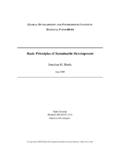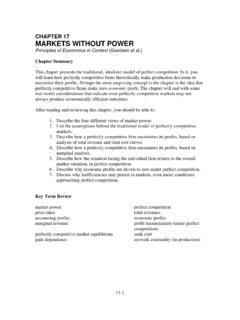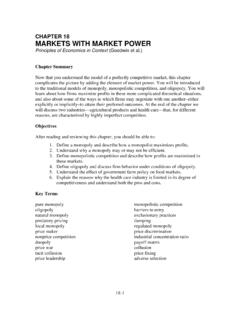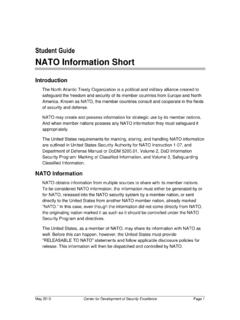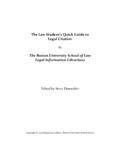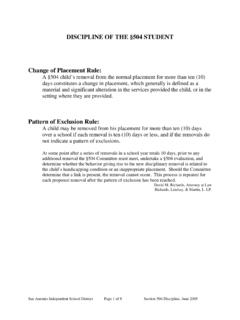Transcription of MICROECONOMICS IN CONTEXT, 1e STUDENT STUDY GUIDE
1 _____ MICROECONOMICS IN CONTEXT, 1e STUDENT STUDY GUIDE _____ By Rachel Massey Revised by Julie A. Nelson, April 2008 GLOBAL DEVELOPMENT AND ENVIRONMENT INSTITUTE Tufts University Medford MA 02155, USA Copyright 2008 Global Development and Environment Institute, Tufts University CHAPTER 1 ECONOMIC ACTIVITY IN CONTEXT MICROECONOMICS in Context (Goodwin, et al.), 1st Edition ( STUDY GUIDE 2008) Chapter Overview This chapter introduces you to the basic concepts that underlie the STUDY of economics. The four essential economic human activities are resource maintenance, the production of goods and services, the distribution of goods and services, and the consumption of goods and services. As you work through this book, you will learn in detail about how economists analyze each of these areas of activity. Objectives After reading and reviewing this chapter, you should be able to: 1.
2 Define the difference between normative and positive questions. 2. Differentiate between intermediate and final goals. 3. Discuss the relationship between economics and well being. 4. Define the four essential economic activities. 5. Illustrate tradeoffs using a production possibilities frontier. 6. Explain the concept of opportunity costs. 7. Summarize the differences between the three spheres of economic activity. 8. Understand what is meant by economics in context. Key Terms economics resource maintenance production distribution consumption positive questions normative questions intermediate goal final goal wealth efficiency well-being economic actor (agent)
3 Negative externalities positive externalities transaction costs exchange transfer abundance scarcity production possibilities frontier (PPF) opportunity cost technological progress core sphere public purpose sphere public goods free riders business sphere informal sphere MICROECONOMICS macroeconomics model traditional microeconomic model economistic thinking 1-1 Active Review Questions Fill in the blank 1.
4 You decide to buy a used car. You discover that it is hard to get information on the quality of the used cars that are available. You have trouble communicating with the car dealer. It takes a considerable amount of time to get the information you need to successfully get the car you had in mind. In other words, buying a used car turns out to be an activity with high _____ costs. 2. A new factory begins discharging pollutants into a previously pristine river. Fish in the river begin to die, and people who make their living through fishing have trouble maintaining their catch. This factory is generating negative _____. 3. Protecting wildlife in a national park is an example of the economic activity of _____. 4. Your grandmother sends you a check for $100. This form of resource distribution is referred to as a _____. 5. A diagram that shows the tradeoffs between production of two goods is called a(n) _____.
5 6. A professional musician practices piano every afternoon. Her neighbor listens to the music and enjoys it. Through her activity, the musician is creating a positive _____. Questions 7 to 10 refer to the production possibilities frontier shown below. AQuantity of ButterQuantity of GunsBDC50 100120300 1-2 True or false 7. In the graph shown above, at point B, society is producing the maximum possible amount of butter. 8. To move from point A to point B, society would have to cut down on its gun production and increase butter production. 9. Starting from point B, society would have to invest substantial resources to increase gun production. 10. Cooking a family dinner at home is an activity of the core sphere of economics.
6 11. MICROECONOMICS is the STUDY of national and international economic trends. 12. Watching a movie is an example of consumption. Short answer 13. Name the two actors in the basic neoclassical, or traditional, model of economics. _____ 14. Children should learn to clean up after themselves by the age of six. Is this a positive or a normative statement? _____ 15. The business sphere contributed 59% of production in the US in 2000. Is this a positive or a normative statement? _____ 16. List the three basic economic questions. _____ 17. What are the two main forms of economic distribution? What is the difference between them? _____ 18. A family enjoys a three-week vacation. In order to afford this vacation, the family saved money over the course of a year. Was earning this money a final goal or an intermediate goal? _____ 19. Technological innovations can vastly increase a society s productive capacity.
7 How might a technological innovation affect a society s production possibilities frontier? 1-3 _____ 20. What is the distinguishing characteristic of institutions in the public purpose sphere? _____ Self Test 1. Which of the following best exemplifies an intermediate goal? a. Spending a relaxing vacation with your family. b. Spending a day at the art gallery. c. Going fishing for fun. d. Getting a summer job so you can afford a trip abroad. e. Reading a novel. 2. Which of the following statements is positive (as opposed to normative)? a. One should always be polite at the dinner table. b. There are ten people in this class. c. A young person s top priority should be job security. d. The best professor is one who meets with students individually each week.
8 E. Resources should be distributed equally across society. 3. Which of the following is an example of a positive externality? a. A musician performs in a concert. People pay to listen to the concert. b. An architect designs a house for herself to live in. She enjoys spending time in the house. c. A STUDENT volunteers in a shelter for the homeless. d. A homeowner plants a tree for shade around her house. The tree also provides shade for her next-door neighbor. e. A teacher drives his car to work and gets stuck in a traffic jam. 4. Which of the following is an example of a negative externality? a. A STUDENT receives a failing grade on a French exam. b. Your roommate throws a loud party that keeps you awake all night. c. You decide to take public transportation to work every day. d. A group of farmers pool their resources to purchase seeds for next year.
9 E. You receive a letter saying your bank account is overdrawn. 1-4 5. Enjoying art at a museum is an example of a. Production b. Consumption c. Exchange d. Transfer e. Resource maintenance 6. Which of the following statements is false? a. Final goals could include fairness, freedom, or a sense of meaning in one s life. b. You are offered a very interesting job, but you need a car to get there. Getting a car is an example of a final goal. c. Resource maintenance refers to activities associated with tending to, preserving, or improving natural, social, and other resources. d. Production is the conversion of resources into goods or services. e. Distribution is the sharing of products and resources among people. 7. Which of the following is an example of the economic activity of resource maintenance?
10 A. cooking dinner b. operating a factory c. providing worker education d. drilling for oil e. buying a bicycle 8. Which of the following factors could expand a society s production possibilities frontier? a. Increased butter production. b. Shifting from one product to another. c. Producing air pollution. d. Depleting resources now instead of later. e. Technological innovations. 9. Which of the following is an example of the economic activity of distribution? a. A baker makes 10 loaves of bread. b. A plumber fixes a leak. c. The legal speed limit is raised from 65 to 75 mph. d. A couple enjoys a walk in the forest. e. A retired worker receives Social Security benefits. 1-5 10. Which of the following is an example of the economic activity of consumption?

